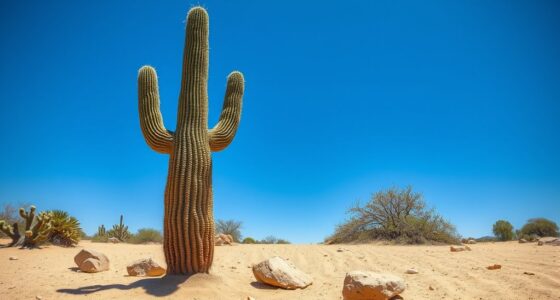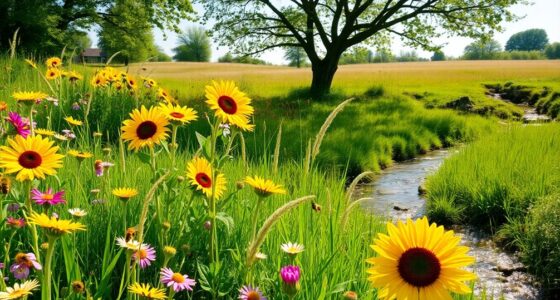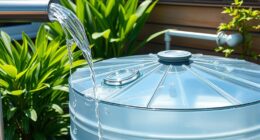Wetlands play a crucial role in maintaining clean water and controlling floods, yet many people overlook their importance. These natural ecosystems act as filters, trapping pollutants and sediments that would otherwise harm our waterways. They also absorb excess rainwater, reducing the risk of flooding in nearby communities. Understanding how wetlands function can help you see why protecting and restoring them is vital for a sustainable future—something you might want to explore further.
The Role of Wetlands in Improving Water Quality
Have you ever wondered how wetlands help keep our water clean? Wetlands act as natural filters, trapping pollutants before they reach larger bodies of water.
As water flows through these areas, plants and soil absorb and break down harmful substances like nutrients, heavy metals, and bacteria. This process significantly reduces contamination levels, improving water quality for ecosystems and human use.
Wetlands also slow down water movement, allowing sediments and pollutants to settle out of the water. By filtering pollutants naturally, wetlands lessen the need for artificial treatment methods.
Their ability to clean water benefits wildlife, supports healthy aquatic habitats, and provides safer water for communities. Essentially, wetlands serve as vital guardians, maintaining the purity of water that sustains life around us. Additionally, the presence of advanced filtration features in some wetlands enhances their capacity to remove contaminants more efficiently.
How Wetlands Absorb and Mitigate Floodwaters
Wetlands play a vital role in controlling floodwaters by acting as natural sponges that absorb excess water during heavy rains or rapid snowmelt. When it rains heavily, wetlands slowly soak up the water, preventing it from rushing into rivers and overwhelming them. The dense vegetation and saturated soils trap and hold water, reducing runoff speed. Unique and Wicked Planters can sometimes be integrated into wetland restoration projects to promote biodiversity and ecological health. This process helps lower the risk of flooding downstream. Additionally, wetlands slow water flow, giving it time to seep into the ground or evaporate. During floods, wetlands act as buffers, soaking up large volumes of water and releasing it gradually. This natural absorption not only protects communities from flood damage but also helps maintain groundwater levels, ensuring the landscape remains resilient during extreme weather events.
The Unique Ecosystems of Wetlands and Their Biodiversity
What makes wetlands truly remarkable is their status as one of the most diverse ecosystems on Earth. You’ll find a wide array of plants, from tall grasses to floating algae, that adapt to constantly changing water levels.
These environments support countless animal species, including birds, amphibians, fish, and insects, each playing a vital role in the ecosystem. Wetlands serve as nurseries for many fish and breeding grounds for migratory birds.
The rich plant life helps stabilize soil and provide food and shelter for wildlife. This incredible biodiversity not only sustains the health of wetlands but also benefits surrounding habitats. Additionally, wetlands’ ability to enhance water quality through natural filtration processes underscores their importance in maintaining ecological balance.
Human Impacts on Wetlands and Their Ecosystem Services
Did you know that human activities have significantly altered wetlands worldwide, threatening their ability to provide vital ecosystem services? Urban development, agriculture, and industrialization have led to draining, filling, and pollution of wetlands.
When wetlands are drained for construction or farming, their natural flood control and water purification functions diminish. Pollution from chemicals, waste, and sediments contaminates the water, harming wildlife and reducing water quality.
Over-harvesting of plants and peat extraction also disrupts these ecosystems. Additionally, infrastructure projects like dams and levees change water flow patterns, impacting wetland health.
These impacts weaken wetlands’ capacity to act as natural water filters and flood buffers, making surrounding communities more vulnerable to flooding, pollution, and climate change effects. Protecting wetlands requires understanding and mitigating these human-induced threats. Recognizing the importance of ecosystem services can motivate conservation efforts and policy changes.
Conservation Strategies for Protecting Wetlands
Effective conservation of wetlands involves implementing a combination of legal protections, restoration efforts, and community engagement. You can support laws that designate wetlands as protected areas, ensuring they’re shielded from development and pollution.
Participating in or advocating for restoration projects helps revive degraded wetlands, restoring their natural functions. Educating local communities about the importance of wetlands encourages sustainable practices and fosters stewardship.
You might volunteer with organizations that monitor wetland health or assist in planting native vegetation. Promoting policies that limit harmful activities, like draining or filling wetlands, is crucial.
Your involvement can influence decision-makers to prioritize wetland preservation. By combining legal action, active restoration, and community participation, you play a vital role in safeguarding these vital ecosystems for future generations.
Understanding ecological functions is essential for developing effective conservation strategies and ensuring wetlands continue to provide their vital benefits.
Restoring Wetlands to Enhance Natural Defenses
Restoring wetlands plays a crucial role in strengthening natural defenses against flooding, storm surges, and erosion. When you rehabilitate degraded wetlands, you help them absorb excess water more effectively, reducing flood risks in nearby communities.
A well-maintained wetland can also support native plant reestablishment, which enhances the ecosystem’s resilience and capacity to provide these protective functions.
Restored wetlands also buffer storm surges, slowing their impact and protecting coastal areas from erosion. By reestablishing native plants and hydrological functions, you improve the wetlands’ ability to trap sediments and filter pollutants.
This natural barrier not only safeguards infrastructure but also preserves habitats for wildlife. Active restoration involves replanting native species, removing invasive plants, and restoring natural water flow.
Your efforts enhance the resilience of these ecosystems, ensuring they continue to provide vital protection and ecological benefits for years to come.
The Future of Wetlands Amid Climate Change
As climate change accelerates, wetlands face increasing threats from rising temperatures, changing precipitation patterns, and more frequent extreme weather events. You might see them shrinking or becoming overwhelmed by floods and droughts.
Rising temperatures can disrupt the delicate balance of plant and animal life, reducing biodiversity and impairing their ability to filter water and control floods.
Altered rainfall patterns may lead to prolonged droughts or intense storms, damaging wetland ecosystems.
Furthermore, the effectiveness of wetlands as water filters and flood defenders depends heavily on their health and natural functions.
However, there’s still hope. By investing in wetland conservation and restoration, you can help protect these vital environments from climate impacts.
Adaptive management strategies, such as creating resilient wetland zones and restoring natural hydrology, will be essential.
Your efforts can ensure wetlands continue to provide their crucial services for future generations.
Conclusion
By protecting and restoring wetlands, you help preserve their crucial role as natural water filters and flood defenses. These ecosystems not only improve water quality and reduce flooding but also support diverse wildlife. Your efforts ensure these vital habitats remain resilient against climate change, benefiting both the environment and communities. Together, we can safeguard wetlands for future generations, maintaining the ecological balance and natural protection that these remarkable landscapes provide.






